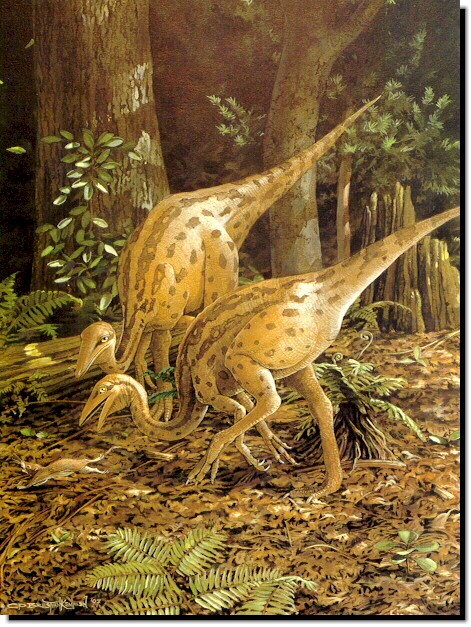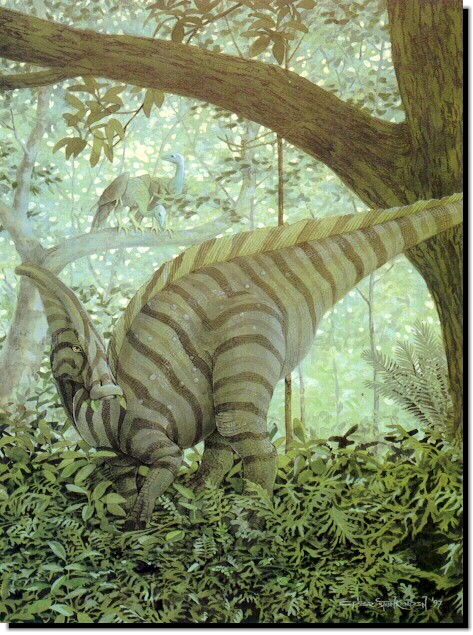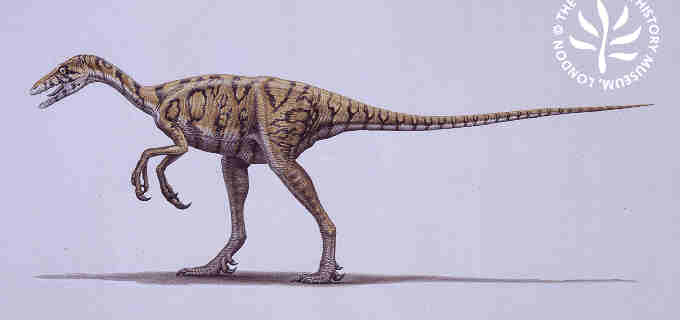



Color illustrations by Carel Brest van Kempen, Dinosaurs of Utah
Story Lines:
Background Information:
The Kaiparowits Formation is one of three formations of Campanian (Late Cretaceous) age that is well-exposed within the boundaries of the monument. Characterized by drab mudstones, siltstones, and sandstones, the formation is composed of stream and levee deposits that were laid down some time between 70 and 82 million years ago. These rocks yield a diverse lower vertebrate fauna.
The Kaiparowits Formations contain extremely significant fossils including marine and brackish water mollusks, turtles, crocodilians, lizards, dinosaurs, fishes, and mammals have been recovered from the Dakota formation, Tropic shale, Straight Cliffs Formation (Tibbet Canyon, Smoky Hollow, and John Henry members), and Wahweap formation in the area. This sequence of rocks(including the overlying Wahweap and Kaiparowits formations) contain perhaps the best and most continuous record of Late Cretaceous terrestrial life in the worldThe Kaiparowits is of interest in understanding the evolution of mammals and other terrestrial vertebrates. Very little is known of Cretaceous mammals prior to the latest part of that period. The mid-Cretaceous mammalian twilight zone is spanned by the fossiliferous, terrestrial rock units of the Kaiparowits region. They contain unique evidence bearing on the early diversification of important mammalian groups of the Late Cretaceous. The thickness, continuity, and broad temporal distribution of the Kaiparowits sequence provides the opportunity to document changes in terrestrial vertebrate assemblages over a wide span of Late Cretaceous time.
(Photos Courtesy of the London Natural History Museum)
| Parasaurolophus was a large bipedal to quadrupedal herbivore best known for its large trombone-shaped crest. This hollow crest is thought to have been used as a resonating chamber for making low frequency sounds for communicating with others of its kind. The crest may also have been used display or for giving it an improved sense of smell. |  |
 |
Struthiomimus was a lightly built toothless carnivorous dinosaur. Its name means ostrich mimic as it was built very much like an ostrich and was also built for high speed running. The identification of Struthiomimus in the Kaiparowits Formation of the Grand Staircase - Escalante National Monument was originally used to correlate these rocks with the North Horn Formation, but continued research in area utilizing microvertebrate fossils and pollen has shown that these rocks are as much as 10 million years older. |
| Troodon is a small meat-eating dinosaur so far recognized in the Kaiparowits Formation only by its distinctive teeth. Most of the dinosaurs known from the Grand Staircase - Escalante National Monument are known only from their teeth found by wet screen washing fossiliferous rock. The study of dinosaurs in the monument is still in its early stages and many new dinosaurs await discovery. Troodon had a small killing claw on its hind foot, which might have been independently developed. This is the most intelligent dinosaur yet discovered based on the size of its brain. |  |
NON-MAMMALIAN VERTEBRATE PALEONTOLOGY OF THE KAIPAROWITS FORMATION IN GRAND STAIRCASE-ESCALANTE NATIONAL MONUMENT AND ADJACENT AREAS OF SOUTHERN UTAH
J. Howard Hutchison, Patricia A.
Holroyd, and Mark B. Goodwin,
Museum of Paleontology, 1101 Valley Life Sciences Building,
University of California, Berkeley, CA 94720
The most common surface finds are the bones of turtles and crocodilians, and these are represented by several genera and families. There are at least two crocodilians represented, a blunt toothed alligator (Brachychampsa, possibly a new species) and a long-snouted, probably pescivorous crocodilian (family Goniophilidae). The chelonian fauna includes early records for and a new genus of kinosternoids (mud turtles) as well as the extinct aquatic family Pleurosternidae (Compsemys). Trionychids (soft-shelled turtles) are the most common taxon. Representatives of several extinct families are also well known. These include the large herbivorous aquatic turtle Adocus (family Adocidae), a large terrestrial herbivorous turtle similar to tortoises (Basilemys: family Nangshuichelvidae), and the riverine turtles NeuranAylus (family Neurankylidae), Boremys "Baena" and (family Baenidae). Where known, the chelonians of the Kaiparowits Formation show similarities to those from the underlying Wahweap Formation.
Dinosaurian remains are well represented by new records of a short-crested lambeosaurine (duck-billed dinosaur), pachycephalosaurs (bone-headed dinosaurs), ornithomimids (ostrich-like forms), and both large and small theropods (carnivorous dinosaurs). Ceratopsians have been found, but are rare. No sauropods are yet known. Dinosaur egg shell was also recovered, indicating the presence of former dinosaur nesting sites.
Fish, sharks, and rays are present, but are less frequently found in surface collections. These fossils, however, are relatively abundant when sediments are sieved and washed to specifically recover small fossils. Sieve washing also yields an abundance of bones from lizards, frogs, and salamanders. Other non-vertebrate fossils include plants (represented by petrified wood and fossil leaves) and mollusks (snails and clams).
The fossils of the Kaiparowits Formation are significant for the high quality of preservation and also for their place within a broader geographic and temporal framework. Compared with the penecontemporanous Judith River Formation in Montana and Canada, the Kaiparowits faunas show several striking differences suggestive of latitudinal or habitat differences. The Kaiparowits Formation yields fewer marine elements and is dominated by more upland faunas and those favoring deep river channels. Chelonian shell size seems to be larger on average than in their northern relatives, and several taxa occur only in the Kaiparowits (Baena, Compsemys, and possibly kinosternoids), evidence of higher diversity in the more southerly faunas. Comparisons with faunas from rocks of similar age and environment of deposition from both the Western Interior of North America (e.g., the Fruitland-Kirtland Formation in New Mexico) and central Asia will add to the emerging picture of a diverse paleocommunity.
Kaiparowits Plateau - Fossil assemblage photographs. Typical mollusks from Tropic Shale, south of Escalante include straight cone cephalopods, ammonites, gastropods, and pelecypods and Cretaceous sharks teeth from the Straight Cliffs Formation.
Kaiparowits,The Blues WSA - Gray Cliffs/Pink Cliffs - This sequence of rocks may contain one of the best and most continuous records of Late Cretaceous terrestrial life in the world. Formation has yielded early mammals, lizards, dinosaurs, crocodilians, turtles, mollusks.
Kaiparowits Plateau, Nipple Bench unit - Fossils deemed by the Museum of Northern Arizona in a 1976 study to be of major importance. They are found in the Cretaceous Wahweap Formation outcrops include abundant fragments of turtle shells and dinosaurs, as well as several crocodile teeth. There is an excellent chance that mammal fossils will be found
Kaiparowits Plateau, Straight Cliffs Formation - The Straight Cliffs Formation is limited to the southern Utah area. It contains primitive mammals including one of the potentially oldest marsupial fossils identified
Kaiparowits Plateau,Carcass Canyon - Invertebrate and vertebrate specimens found Straight Cliffs, Tropic Shale, and Dakota Formations. 13 collection sites recorded (gastropods, cephalopods in upper Cretaceous Formations, vertebrate in Dakota and Tropic Shales). Likely to occur along entire length of the Straight Cliffs
References:
A preliminary assessment of paleontological resources within the Grand Staircase-Escalante National Monument, Utah by D.D. Gillette and M.C. Hayden, 34 p., 1997, C-96 $4.00
BLM, Escalante/Kanab RMP - Grand Staircase Ecosystem Analysis, 1994
CRETACEOUS VERTEBRATE FAUNAS FROM THE KAIPAROWITS PLATEAU, SOUTH-CENTRAL UTAH 345
Jeffrey G. Eaton, Richard L. Cifelli, J. Howard Hutchison, James I. Kirkland, and J.
Michael Parrish
DeCourten, Dinosaurs of Utah, The University of Utah Press, Salt Lake City, 1998.
Eaton, Jeffrey G, and Cifelli, Richard L. Preliminary report on Late Cretaceous mammals of the Kaiparowits Plateau, southern Utah, 1988